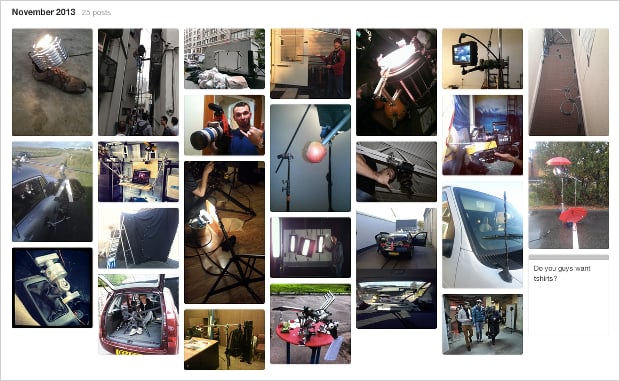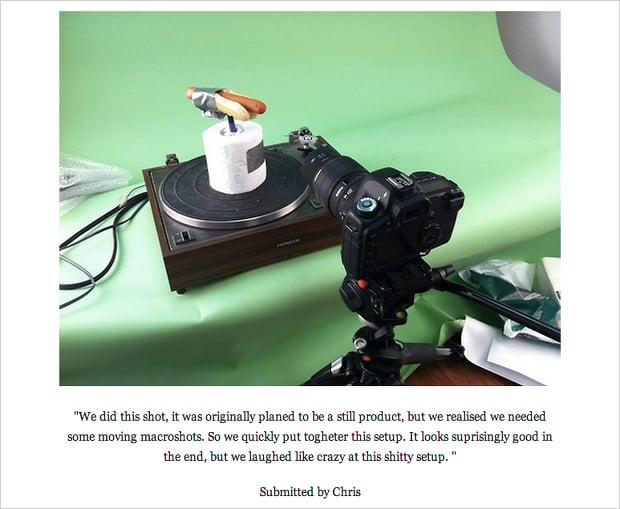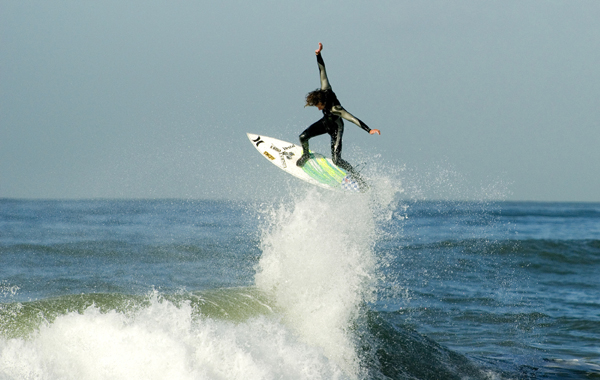Found this on petapixel.com .. Check it out:

You might have found yourself in this situation before: you’re in the middle of a photo shoot and you find that you badly need to set up a shot or lighting that is, in fact, impossible to do ‘professionally’ given the gear you have on hand.
So what do you do? You go all MacGyver of course! You put together an off-the-top-of-your-head DIY fix that gets the job done (even if it doesn’t look all that good doing it). The Tumblr blogShitty Rigs is dedicated to showing off those brilliant, if a bit silly, creations.
Shitty Rigs was started by Bert Mayer and Mike Farino all the way back in November of 2011 with the purpose of sharing the most inventive, ridiculous and often funny rigs they sometimes find themselves putting together on set.
From the blog description:

Although the site was started with filmmaking in mind, we have a feeling many (if not all) the photographers we know have had to do this a time or two themselves. From strange and inventive ways to keep lights and cameras aloft, to hilarious mess-ups by assistants who managed to turn a simple task into something downright complicated, there’s a lot to laugh at here.
And for those of you concerned about safety, Mayer and Farino have assured their readers on several occasions that none of their rigs have ever led to someone getting hurt. “I just wanted to remind you that we are all professionals trying to get a job done,” they write. “We are all here for fun and to share stories from set. And let’s be honest, the director made us do it.”
You can check out their full selection of ridiculous rigs over on the website itself by clickinghere. And keep in mind, they take submissions too! Photographers are still underrepresented amongst all the filmmakers on there, so if you’ve ever created a ‘shitty rig’ worthy of MacGyver fame, submit it on their site and drop us a link in the comments down below.
(via Reddit)
You might have found yourself in this situation before: you’re in the middle of a photo shoot and you find that you badly need to set up a shot or lighting that is, in fact, impossible to do ‘professionally’ given the gear you have on hand.
So what do you do? You go all MacGyver of course! You put together an off-the-top-of-your-head DIY fix that gets the job done (even if it doesn’t look all that good doing it). The Tumblr blogShitty Rigs is dedicated to showing off those brilliant, if a bit silly, creations.
Shitty Rigs was started by Bert Mayer and Mike Farino all the way back in November of 2011 with the purpose of sharing the most inventive, ridiculous and often funny rigs they sometimes find themselves putting together on set.
From the blog description:
If you have worked on a film set, you know. Grip and electric is all about doing everything you have to with all the gear you don’t have. Here’s to all the horrible things we have done with our gear to get the shot we need.
Although the site was started with filmmaking in mind, we have a feeling many (if not all) the photographers we know have had to do this a time or two themselves. From strange and inventive ways to keep lights and cameras aloft, to hilarious mess-ups by assistants who managed to turn a simple task into something downright complicated, there’s a lot to laugh at here.
And for those of you concerned about safety, Mayer and Farino have assured their readers on several occasions that none of their rigs have ever led to someone getting hurt. “I just wanted to remind you that we are all professionals trying to get a job done,” they write. “We are all here for fun and to share stories from set. And let’s be honest, the director made us do it.”
You can check out their full selection of ridiculous rigs over on the website itself by clickinghere. And keep in mind, they take submissions too! Photographers are still underrepresented amongst all the filmmakers on there, so if you’ve ever created a ‘shitty rig’ worthy of MacGyver fame, submit it on their site and drop us a link in the comments down below.
(via Reddit)




 This introductory tutorial on Surf Photography has been submitted by Ryan Cardone from
This introductory tutorial on Surf Photography has been submitted by Ryan Cardone from 
